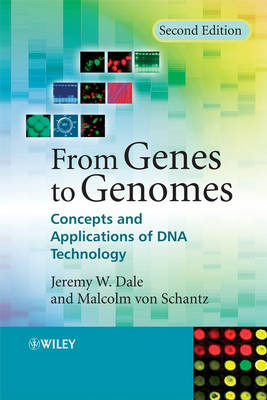
From Genes to Genomes
Wiley-Blackwell (Verlag)
978-0-470-01734-0 (ISBN)
- Titel ist leider vergriffen;
keine Neuauflage - Artikel merken
Finally, the book moves on to consider some of the applications of these techniques, in biotechnology, medicine and agriculture, as well as in research that is causing the current explosion of knowledge across the biological sciences. From Genes to Genomes: Concepts and Applications of DNA Technology, Second Edition includes full two-colour design throughout. Specific changes for the new edition include: * Strengthening of gene to genome theme * Updating and reinforcing of material on proteomics, gene therapy and stem cells * More eukaryotic/mammalian examples and less focus on bacteria This textbook is must-have for all undergraduates studying intermediate molecular genetics within the biological and biomedical sciences. It is also of interest for researchers and all those needing to update their knowledge of this rapidly moving field.
Professor Jeremy Dale and Dr Malcolm von Schantz. School of Biomedical and Molecular Sciences, University of Surrey, Guildford, Surrey GU2 SXH, UK.
Preface. 1 Introduction. 2 Basic molecular biology. 2.1 Nucleic acid structure. 2.2 What is a gene? 2.3 Information flow: gene expression. 2.4 Gene structure and organization. 3 How to clone a gene. 3.1 What is cloning? 3.2 Overview of the procedures. 3.3 Gene libraries. 3.4 Hybridization. 3.5 Polymerase chain reaction. 3.6 Extraction and purification of nucleic acids. 3.7 Detection and quantitation of nucleic acids. 3.8 Gel electrophoresis. 4 Cutting and joining DNA. 4.1 Restriction endonucleases. 4.2 Ligation. 4.3 Modification of restriction fragment ends. 4.4 Other ways of joining DNA molecules. 5 Vectors. 5.1 Plasmid vectors. 5.2 Vectors based on the lambda bacteriophage. 5.3 Cosmids. 5.4 M13 vectors. 5.5 Expression vectors. 5.6 Vectors for cloning and expression in eukaryotic cells. 5.7 Supervectors: YACs and BACs. 5.8 Summary. 6 Genomic and cDNA libraries. 6.1 Genomic libraries. 6.2 Growing and storing libraries. 6.3 cDNA libraries. 6.4 Random, arrayed and ordered libraries. 7 Finding the right clone. 7.1 Screening libraries with gene probes. 7.2 Screening expression libraries with antibodies. 7.3 Subcloning. 7.4 Characterization of plasmid clones. 8 Polymerase chain reaction. 8.1 The PCR reaction. 8.2 PCR in practice. 8.3 Cloning PCR products. 8.4 Long-range PCR. 8.5 Reverse-transcription PCR. 8.6 Rapid amplification of cDNA ends. 8.7 Quantitative PCR. 8.8 Applications of PCR. 9 Characterization of a cloned gene. 9.1 DNA sequencing. 9.2 Databank entries and annotation. 9.3 Sequence analysis. 9.4 Sequence comparisons. 9.5 Protein structure. 9.6 Confirming gene function. 10 Analysis of gene expression. 10.1 Analysing transcription. 10.2 Methods for studying the promoter. 10.3 Regulatory elements and DNA-binding proteins. 10.4 Translational analysis. 11 Products from native and manipulated cloned genes. 11.1 Factors affecting expression of cloned genes. 11.2 Expression of cloned genes in bacteria. 11.3 Expression in eukaryotic host cells. 11.4 Adding tags and signals. 11.5 In vitro mutagenesis. 11.6 Vaccines. 12 Genomic analysis. 12.1 Genome sequencing. 12.2 Analysis and annotation. 12.3 Comparing genomes. 12.4 Genome browsers. 12.5 Relating genes and functions: genetic and physical maps. 12.6 Transposon mutagenesis and other screening techniques. 12.7 Conclusion. 13 Analysis of genetic variation. 13.1 Single nucleotide polymorphisms. 13.2 Larger-scale variations. 13.3 Other methods for studying variation. 13.4 Human genetic diseases. 13.5 Molecular phylogeny. 14 Post-genomic analysis. 14.1 Analysing transcription; transcriptomes. 14.2 Array-based methods. 14.3 Translational analysis; proteomics. 14.4 Post-translational analysis: protein interactions. 14.5 Integrative studies; systems biology. 15 Modifying organisms; transgenics. 15.1 Modification of bacteria and viruses: live vaccines. 15.2 Transgenesis and cloning. 15.3 Animal transgenesis. 15.4 Applications of transgenic animals. 15.5 Transgenic plants and their applications. Glossary. Bibliography. Index.
| Erscheint lt. Verlag | 1.11.2007 |
|---|---|
| Zusatzinfo | col. illustrations |
| Verlagsort | Hoboken |
| Sprache | englisch |
| Maße | 171 x 244 mm |
| Gewicht | 950 g |
| Einbandart | Paperback |
| Themenwelt | Informatik ► Weitere Themen ► Bioinformatik |
| Naturwissenschaften ► Biologie ► Genetik / Molekularbiologie | |
| ISBN-10 | 0-470-01734-1 / 0470017341 |
| ISBN-13 | 978-0-470-01734-0 / 9780470017340 |
| Zustand | Neuware |
| Haben Sie eine Frage zum Produkt? |
aus dem Bereich


